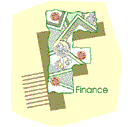Bonds can be purchased at any time. To value the bond, the procedures differ depending on whether the bond is purchased on the date interest is regularly paid (interest date) or whether it is purchased “between interest dates”.
 How to calculate the Purchase Price of a Bond on an Interest Date
How to calculate the Purchase Price of a Bond on an Interest Date
Formula to be used:
PP = R[1-(1+i)^-n]
—————— + RD (1+i) ^ -n
i
Valuing Bonds
Example:
A $5,000 bond pays the holder an interest rate of 10% payable semi-annually. The bond will be redeemed at par in 10 years. An investor wants to purchase the bond on the bond market to yield a return of 12% payable semi-annually. What would be the purchase price of the bond?
Solution:
Since the bond pays 10% on $5,000 semiannually, the regular interest payment will be:
R = F * r
= $5,000[0.1 / 2]
= $250
From the information given, the remaining number of interest periods is:
N=10*2, or 20
The redemption value of the bond in ten years is the par value or the face value of the bond:
RD = $5,000
Now to compute the purchase price, we must calculate the present values of the payments and the redemption value. Since the yield rate is the rate the investor wants to receive, it is the rate we must use to find the present values in determining the purchase price. Substituting the values into our formula, we have:
PP = $250[1-(1+i) ^ -n]
———————— + $ 5,000(1+i) ^ -n
I
(the payments part of the + (the redemption part of the
formula) formula)
Substituting the remaining values gives:
I = 0.12 /2, or 0.06 yield rate
N= 20
PP= $250[1-(1+0.06) ^ -20]
—————————— + $5,000(1+0.06) ^ -20
0.06
PP = $2,867.50 +$1,559.02
PP (purchase price) = $4,426.52
How to calculate the Purchase Price of a Bond, if it is purchased between interest dates:
Most bond sales occur between interest dates.
Example: Consider the same example given above. Assume the bond is purchased 156 days after April 1 (the interest date).
Then the purchase price would be:
$ 4,426.52 [1 + 0.06(156/183)]
(as calculated in the above example)
PP = $ 4,652.93
The issuer may at the time of issue of the bonds commit to redeem the bonds at a premium. Assume that in the above example the bonds are to be redeemed at 102; this means that for every dollar of face value, $ 1.02 will be paid upon redemption.
The reason an issuer may offer such an arrangement is to encourage people to buy the bond and hold until it is redeemed. To this investor this represents a slight increase in the return. In the above example, the $5,000 bond would be redeemed at $5,100. To calculate the purchase price, replace the $5,000 considered in the redemption value of the formula by $ 5,100.